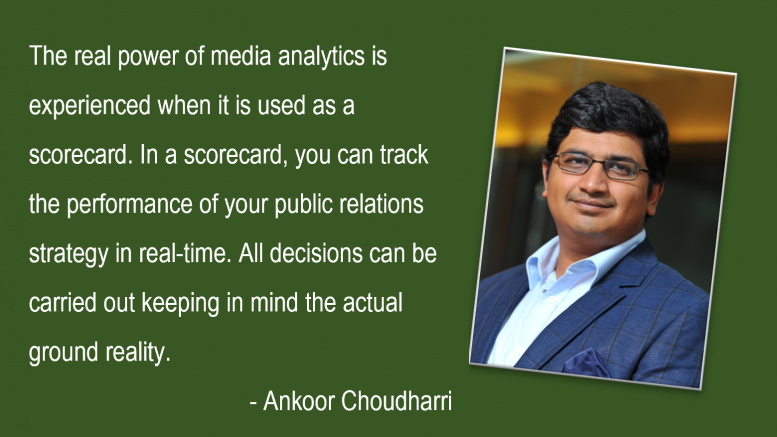The last few years witnessed an exponential growth in the demand for Media Analytics. However, sadly though, its usage has been limited to a report card to track the performance of public relations campaigns. One needs to realise that if media analytics is used as a report card, you are already behind the curve, and correction can only be carried out later.
The real power of media analytics is experienced when it is used as a scorecard. In a scorecard, you can track the performance of your public relations strategy in real-time. All decisions can be carried out keeping in mind the actual ground reality. Course correction can be done in real-time.
Post pandemic media upheaval, extremely pervasive & on-your-face social media, and the increasing tribe of DTC brands are some of the imperatives that have accelerated the use of media analytics as part of communication strategy and not as a postscript.
With this as a background, how can intelligent media analytics add punch to all stages of your communication strategy?
Pre Communication Stage- The planning
The actual strength of the media analytics is seen in the pre-communication phase itself. Therefore, before getting into the performance of the communication campaign, it is vital to set some benchmarks to judge performance.
- Benchmarking Study: Benchmarks can be set on a brand and campaign level. At a brand level, past performance can be checked. The areas where a brand has not exceeded expectations can be identified. A special message can be developed for that audience or area. This can be aligned with the overall brand objective. On a campaign level, the performance of a similar or related brand campaign can be studied to create a proper benchmark for performance.
-
- Narrative Creation: Media analytics can be used to find out the narratives that are prevalent in a particular industry. It can be benchmarked with the competition to find out their narrative. How well the targets receive narratives can also be studied. What do they place in each story segment – corporate, HR, CSR can be learned. Then a holistic narrative can be designed that plugs the gaps and build on the existing context.
- Journalist identification and profiling: Once the brand message and targets are identified, then a database of journalists can be created, keeping in mind how they will further the brand narrative. Journalists can be defined by their reach, Multiplier effect, Multimedia contribution, writing style, Column selections, Beat selections, Pro and Against, and writing trends. A media dipstick should be carried out to map actual journalists’ responses to their media contributions.
- Stakeholder tracking and listening: Before launching the campaign, all brand stakeholders should be heard. Focus on stakeholders’ views and understand their media reach and start mapping the impact in those media
- Identify publications/websites: Focus on multi editions, higher reach, and publications that are relevant to the brand
During Communications-The execution
In this phase, real-time monitoring comes into play. A comprehensive view keeps in mind the dissemination of the message, its reception by the targets, and its impact. In addition, any message distortion or variance in traditional and social media is tracked and then corrected if needed.
- Active media monitoring: is carried out at the brand and competition levels. At the brand level, how the message is traveling across various media, how the brand messaging is moving, keep an eye on the negative buzz, and get your campaign/Press release performance report. The competition is tracked to see how it responds to the campaign.
- Real-time dashboard: Design a dashboard that captures all data in real-time and displays it in a fashion that helps fast decision-making.
Post Communications: The impact assessment
If we do the first two phases well, this is the easiest. Here the emphasis is on assessing how much the brand messaging has met its pre-campaign goals. Some of the tools that we can use are
- In-depth Qualitative Reporting: Get the Answer of What, When, How, Where, Who, and Why. Where there is scope for improvement, it should be built into the follow-up campaign.
- Impact assessment: Share of voice, thematic analysis, Impact analysis, sentiment analysis, thought leadership, Journalist profiling, Publications profiling, Article type, Prominence, visibility, etc., should be analysed against the communication sent out. All hits, missed points, and insights should be used to plan the Way forward and include more customisations.
- Insight/Trend Reports: understand any specific events in detail – press releases, campaigns, adverse impact, announcements etc.
These are just some thoughts that I wanted to share with you on the effectiveness of media analytics in communication and particularly public relations
The views and opinions published here belong to the author and do not necessarily reflect the views and opinions of the publisher.



Be the first to comment on "Is Media Analytics Your Report Card or a Score Card?"